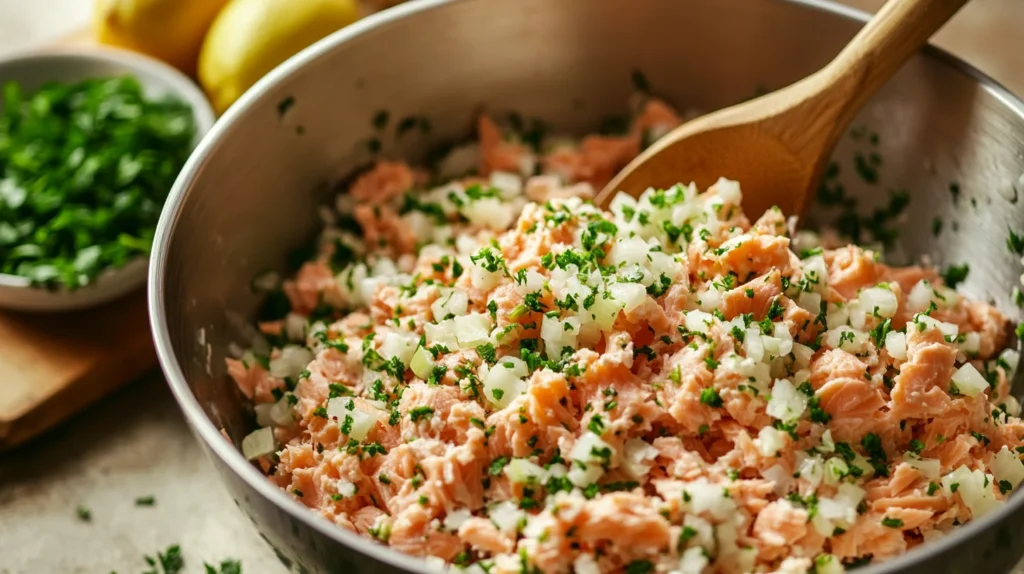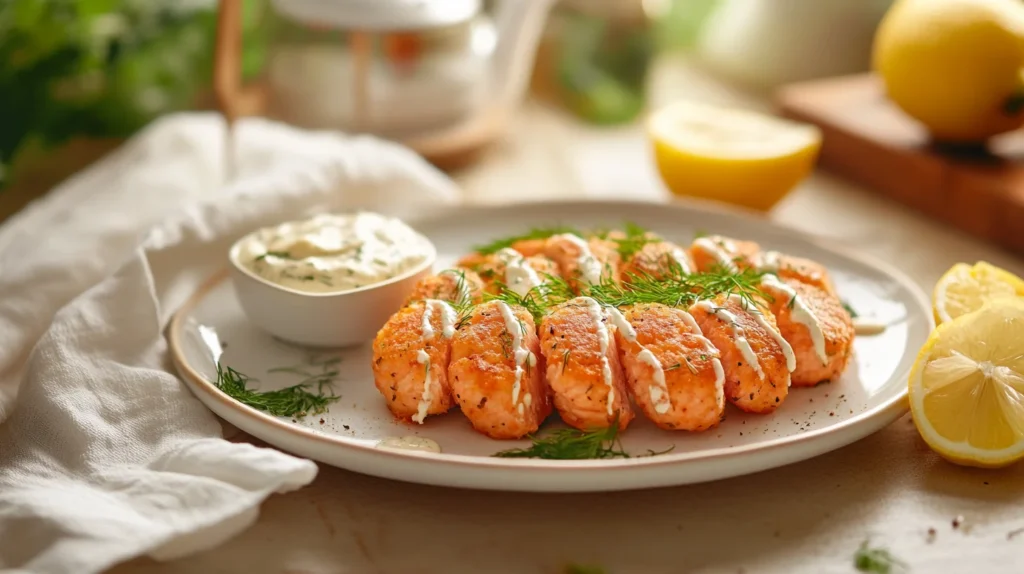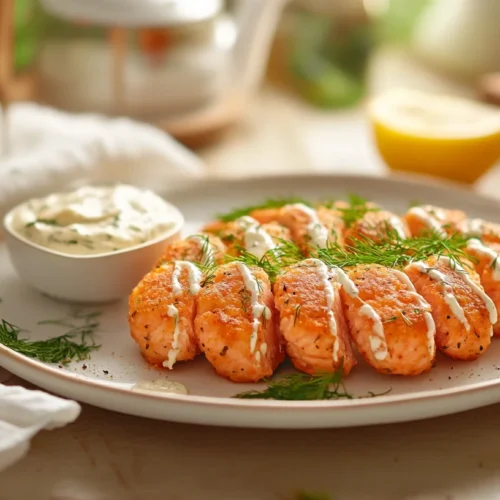Salmon cakes are a versatile, flavorful dish that works for a variety of occasions—from casual family dinners to elegant appetizers at a party. With their crisp exterior and tender, savory interior, these cakes pack a punch of flavor while being easy to prepare. Made with simple ingredients like salmon, breadcrumbs, and herbs, this salmon cakes recipe is a fantastic way to enjoy the nutritional benefits of salmon without breaking the bank.
Whether you prefer fresh or canned salmon, this easy salmon cakes recipe can be customized to fit your taste and dietary needs. Plus, with multiple cooking options like frying, baking, or even air-frying, it’s easier than ever to create the perfect homemade salmon cakes in your own kitchen.
In this article, we’ll walk you through everything you need to know about the best salmon cakes recipe, from selecting the right ingredients to serving suggestions and nutritional information. Let’s dive into the ultimate guide to making crispy salmon cakes that everyone will love!

Ingredients for Salmon Cakes
To create salmon cakes that are both delicious and easy to make, choosing the right ingredients is essential. Whether you’re using canned salmon for convenience or fresh salmon for premium flavor, assembling the correct combination of ingredients will ensure your cakes are a hit.
Choosing Fresh vs. Canned Salmon
- Fresh Salmon:
Opting for fresh salmon gives you maximum control over the flavor and texture. Fresh salmon can be steamed, grilled, or baked before flaking it for the recipe. This method is ideal for those who prioritize quality and taste. - Canned Salmon:
Canned salmon is an excellent choice for quick and affordable salmon cakes. Ensure the canned salmon you choose is of good quality, and don’t forget to drain and remove large bones (though small bones are edible and rich in calcium).
Essential Ingredients for Flavor and Texture
Here’s a list of must-have ingredients for making salmon cakes:
- Salmon (fresh or canned): The star ingredient, rich in omega-3 fatty acids and protein.
- Breadcrumbs or Panko: These provide the cakes with structure and a satisfying crunch.
- Eggs: A vital binding agent to hold the cakes together.
- Mayonnaise or Greek Yogurt: Adds moisture and a creamy texture.
- Herbs (e.g., parsley, dill, chives): Fresh herbs enhance the flavor and aroma of the salmon cakes.
- Onion (finely chopped): For a mild and sweet depth of flavor.
- Seasonings (e.g., salt, pepper, paprika): Balances and intensifies the flavors of the cakes.

Optional Ingredients to Customize Your Recipe
Customizing salmon cakes allows you to tailor the dish to your preferences:
- Lemon Zest or Juice: Brightens the flavor profile.
- Garlic (minced): Adds an aromatic punch.
- Capers: Introduce a briny tang that complements salmon.
- Cheese (e.g., Parmesan or Feta): For a richer, creamier taste.
- Hot Sauce or Red Pepper Flakes: For a spicy kick.
- Vegetables (e.g., bell peppers, celery): Add crunch and a pop of color.
These ingredients can be adjusted to suit dietary needs or to experiment with different flavor profiles.
Step-by-Step Instructions
Creating salmon cakes is a straightforward process, and the steps are easy to follow. By carefully preparing each component, you can ensure that your cakes turn out perfectly every time. Let’s dive into the detailed instructions.
Preparing the Salmon
- For Fresh Salmon:
- Cook the Salmon: Bake, grill, or steam the salmon until fully cooked. Let it cool slightly, then flake it into small pieces using a fork. Remove any skin and visible bones.
- Season: Lightly season the salmon with salt and pepper for an extra layer of flavor.
- For Canned Salmon:
- Drain the Salmon: Open the can and drain the liquid.
- Check for Bones: Remove any large bones or skin (small bones are fine as they’re edible and nutritious).
- Flake the Meat: Use a fork to flake the salmon into smaller pieces.
Mixing the Ingredients
In a large mixing bowl, combine the following:
- Flaked Salmon: Add your prepared salmon.
- Binding Ingredients: Crack one or two eggs into the bowl. This helps hold the mixture together.
- Moisture Ingredients: Add a dollop of mayonnaise or Greek yogurt for a creamy consistency.
- Breadcrumbs: Mix in breadcrumbs or panko to absorb moisture and provide structure. Start with a small amount and adjust as needed.
- Flavor Boosters: Add chopped onion, minced garlic, fresh herbs, and seasonings like paprika, salt, and pepper.
- Optional Add-Ins: Incorporate any extras, like lemon zest, capers, or cheese, for a customized touch.
Mixing Technique:
- Gently mix the ingredients until just combined. Overmixing can make the cakes dense and tough. Aim for a texture that holds together when pressed but isn’t overly dry.
Shaping the Salmon Cakes
- Portioning:
- Scoop about 1/4 to 1/3 cup of the mixture and roll it into a ball.
- Flatten gently into a patty shape about 3/4-inch thick.
- Uniformity:
- Use a cookie scoop or measuring cup to ensure all patties are the same size for even cooking.
- Chilling (Optional):
- Place the formed patties on a baking sheet and refrigerate for 15-30 minutes. This step helps them firm up and reduces the risk of breaking during cooking.
Cooking Methods: Frying, Baking, or Air-Frying
- Pan-Frying:
- Heat a few tablespoons of oil (e.g., olive or vegetable oil) in a skillet over medium heat.
- Cook each patty for 3-4 minutes per side until golden brown and crisp.
- Place on a paper towel to drain excess oil.
- Baking:
- Preheat your oven to 400°F (200°C).
- Arrange the patties on a greased or parchment-lined baking sheet.
- Bake for 15-20 minutes, flipping halfway through, until lightly browned.
- Air-Frying:
- Preheat the air fryer to 375°F (190°C).
- Spray the patties lightly with oil and place them in the basket.
- Cook for 8-10 minutes, flipping halfway through, until golden and crisp.
Tips for Perfect Salmon Cakes
Making salmon cakes is simple, but incorporating some expert tips can take your recipe to the next level. From ensuring they stay intact during cooking to achieving that perfect golden crisp, these tips will help you master the art of salmon cakes.
Binding Agents: Keeping Your Cakes Together
- Eggs Are Essential:
- Eggs act as a glue that binds the ingredients together. Ensure you use the right amount—typically one egg per 1-1.5 cups of salmon.
- Adjust Breadcrumbs Carefully:
- Add breadcrumbs gradually, as too much can dry out the cakes. If the mixture feels too wet, sprinkle in more breadcrumbs until it holds together when pressed.
- Chilling the Mixture:
- Refrigerate the mixture or shaped patties for 15-30 minutes before cooking. This step helps firm up the cakes, reducing the chances of them falling apart in the pan or oven.
Achieving the Perfect Crisp
- Use the Right Oil:
- Choose oils with a high smoke point, like vegetable, canola, or avocado oil, for frying. These oils help achieve a golden-brown crust without burning.
- Preheat the Pan:
- Always preheat your skillet before adding the patties. A hot pan helps create a crisp exterior and prevents sticking.
- Avoid Overcrowding:
- Fry the cakes in batches to allow enough space for even cooking. Overcrowding can lower the temperature, making the cakes soggy instead of crispy.
- Opt for Panko:
- For an extra crispy texture, use panko breadcrumbs instead of regular breadcrumbs.
Pairing Salmon Cakes with Sides
- Dipping Sauces:
- Pair your salmon cakes with flavorful sauces like tartar sauce, aioli, or a lemon-dill yogurt dip for added zest.
- Light and Fresh Sides:
- A fresh green salad, coleslaw, or steamed vegetables complement the richness of the salmon cakes.
- Hearty Options:
- Serve the cakes with roasted potatoes, quinoa, or rice pilaf for a more filling meal.
- Bread Options:
- Turn your salmon cakes into a sandwich by serving them on a brioche bun with lettuce, tomato, and a dollop of your favorite sauce.
Additional Tips for Success
- Test a Small Batch First:
- Fry a small piece of the mixture to test seasoning and texture. Adjust as needed before cooking the rest.
- Keep it Fresh:
- Use fresh herbs and lemon juice for a vibrant flavor profile that enhances the natural taste of salmon.
- Don’t Rush Cooking:
- Cook over medium heat to ensure the cakes are cooked through without burning the exterior.
Variations of Salmon Cakes
This salmon cakes recipe is highly versatile and can be tailored to suit various dietary needs, flavor preferences, and culinary styles. Whether you’re following a gluten-free diet, looking for keto-friendly options, or simply experimenting with new flavors, these homemade salmon cakes provide endless possibilities. Here, we explore some popular variations of this easy salmon cakes recipe that add unique twists to the classic dish.
Gluten-Free Salmon Cakes
For those with gluten sensitivities or those looking to avoid gluten:
- Swap Breadcrumbs:
- Replace traditional breadcrumbs with gluten-free breadcrumbs, crushed gluten-free crackers, or almond flour.
- Ensure Binding:
- Use eggs and a small amount of mashed sweet potato or cooked quinoa as a binder to maintain consistency.
- Flour Alternatives:
- Lightly coat the cakes in rice flour or cornstarch before cooking for a crisp exterior.
Serving Suggestion: Pair these cakes with a tangy lemon-yogurt sauce or a gluten-free tartar sauce.

Keto-Friendly Salmon Cakes
To make salmon cakes low in carbs and suitable for a ketogenic diet:
- Low-Carb Binders:
- Use almond flour, crushed pork rinds, or flaxseed meal instead of breadcrumbs.
- High-Fat Ingredients:
- Incorporate full-fat mayonnaise, cheese, or a small amount of cream cheese to enhance flavor and meet keto macros.
- Cook with Healthy Fats:
- Fry the cakes in coconut oil, avocado oil, or clarified butter for added health benefits.
Pro Tip: Serve with avocado slices or a creamy garlic aioli for a keto-approved side.
Adding International Flavors
Transform your salmon cakes into a global delight by incorporating spices, herbs, and other ingredients inspired by international cuisines.
- Asian-Inspired Salmon Cakes:
- Add soy sauce, sesame oil, ginger, and scallions to the mixture.
- Serve with a dipping sauce made of soy sauce, rice vinegar, and a touch of honey.
- Mediterranean Salmon Cakes:
- Include feta cheese, chopped olives, and fresh dill.
- Serve with tzatziki or a lemon-caper yogurt sauce.
- Caribbean Salmon Cakes:
- Mix in jerk seasoning, bell peppers, and a hint of lime juice.
- Pair with a mango salsa or spicy mayo for a tropical touch.
- Indian-Style Salmon Cakes:
- Use curry powder, turmeric, cilantro, and green chilies.
- Serve with a cooling cucumber raita or tamarind chutney.
Budget-Friendly Salmon Cakes
- Using Canned Ingredients:
- Opt for canned salmon and pantry staples to reduce costs without sacrificing flavor.
- Stretching the Mixture:
- Add mashed potatoes, cooked rice, or finely grated vegetables like zucchini to increase the yield.
- Simplified Seasoning:
- Stick to salt, pepper, and a splash of lemon juice for a minimalist yet delicious option.
Creative Shapes and Serving Ideas
- Mini Salmon Cakes:
- Form smaller patties to serve as bite-sized appetizers or snacks.
- Salmon Cake Sliders:
- Make slider-sized cakes and serve them on mini buns with toppings like arugula and garlic aioli.
- Salmon Cake Bowls:
- Serve the cakes over a bed of greens, quinoa, or rice, drizzled with your favorite dressing.
Nutritional Information
A salmon cakes recipe is not only a delicious dish but also a nutritious option packed with essential vitamins, minerals, and healthy fats. These homemade salmon cakes are rich in omega-3 fatty acids, making them a heart-healthy choice for any meal. In this section, we’ll break down the nutritional benefits of a salmon cakes recipe and offer tips on how to make the best healthy salmon cakes even more nutritious. Whether you’re using fresh or canned salmon, this salmon cakes recipe is an excellent way to enjoy a balanced, flavorful meal.
Health Benefits of Salmon
- Rich in Omega-3 Fatty Acids:
- Salmon is an excellent source of omega-3s, which are crucial for heart health, reducing inflammation, and supporting brain function.
- High-Quality Protein:
- Each serving of salmon provides a significant amount of protein, helping to build and repair tissues.
- Loaded with Vitamins and Minerals:
- Salmon is rich in B vitamins, potassium, selenium, and vitamin D, all of which contribute to overall health.
- Low in Calories:
- Compared to other protein sources, salmon is relatively low in calories while offering a high nutrient density.
Caloric Content and Macronutrient Breakdown
The nutritional content of salmon cakes varies based on the recipe, but a standard serving (one medium-sized cake) typically includes:
- Calories: 200-250
- Protein: 15-20 grams
- Carbohydrates: 10-15 grams (from breadcrumbs or added starches)
- Fat: 10-15 grams (from salmon, eggs, and cooking oil)
- Omega-3s: 1,000–1,500 mg
How to Make Your Recipe Healthier
If you’re looking to enhance the nutritional profile of your salmon cakes, here are some adjustments you can make:
- Reduce Added Fats:
- Use an air fryer or bake the cakes instead of frying them to minimize oil consumption.
- Boost Fiber:
- Replace breadcrumbs with rolled oats or flaxseed meal for added fiber and nutrients.
- Incorporate Vegetables:
- Add finely grated carrots, zucchini, or spinach to the mixture for extra vitamins and minerals.
- Opt for Whole-Grain Options:
- Use whole-grain breadcrumbs or crushed whole-grain crackers to increase fiber content.
- Limit Sodium:
- Use low-sodium canned salmon and seasonings to keep salt levels in check.
- Use Healthy Oils:
- Swap traditional vegetable oil with olive oil or avocado oil for heart-healthy fats.
Comparing Fresh and Canned Salmon Nutrition
Both fresh and canned salmon are nutritious, but there are slight differences:
- Fresh Salmon:
- Higher in omega-3 fatty acids and fresher in taste.
- Typically lower in sodium.
- Canned Salmon:
- A convenient option that is still rich in nutrients.
- Contains edible bones, which are an excellent source of calcium.
By understanding the nutritional breakdown and making thoughtful adjustments, you can enjoy salmon cakes that align with your dietary goals while still being flavorful and satisfying.
Related Recipes to Explore
Enhance your seafood repertoire with these related recipes:
- Salmon Patties Recipe
Learn how to make another version of salmon patties that are equally delicious and perfect for weeknight meals. - Fish Food Recipe
Discover a variety of fish-based dishes that complement the flavors of salmon cakes. - Mexican Pizza Recipe
For those seeking variety, try this creative take on a Mexican-inspired pizza recipe.
Frequently Asked Questions
How Do You Keep Salmon Patties From Falling Apart?
Keeping salmon patties intact during cooking can be tricky, but it’s achievable with the right techniques:
- Use a Binding Agent: Ingredients like eggs and breadcrumbs or panko help bind the mixture. Ensure you use enough to hold the patties together.
- Drain Excess Moisture: If using canned salmon, drain it thoroughly. For fresh salmon, pat it dry with a paper towel before mixing.
- Chill the Mixture: Refrigerate the mixture or formed patties for 15–30 minutes before cooking to firm them up.
- Handle Gently: Avoid overmixing or overhandling the patties, as this can weaken the structure.
- Cook at the Right Temperature: Preheat your pan or oven properly to ensure the patties cook evenly without breaking.
What Are the Ingredients in Salmon Cakes?
The core ingredients in traditional salmon cakes include:
- Salmon: Freshly cooked or canned salmon serves as the base.
- Binding Agents: Eggs and breadcrumbs or panko help hold the mixture together.
- Moisturizers: Ingredients like mayonnaise or Greek yogurt add moisture.
- Flavor Enhancers: Herbs (e.g., parsley, dill), onion, garlic, salt, pepper, and sometimes lemon zest.
- Optional Add-Ins: Cheese, capers, or spices for a unique flavor twist.
These ingredients can be adjusted to suit dietary preferences, such as making gluten-free or keto-friendly versions.
What Can You Use Instead of Breadcrumbs in Salmon Patties?
If you’re out of breadcrumbs or prefer an alternative, consider these substitutes:
- Panko: For a crispier texture.
- Crushed Crackers: Saltine or gluten-free crackers work well.
- Almond Flour or Coconut Flour: Ideal for low-carb or keto diets.
- Mashed Potatoes: Great for binding and adding moisture.
- Oats: Rolled oats or quick oats can provide structure and fiber.
- Quinoa: Cooked quinoa adds a nutritious, grainy texture.
- Ground Flaxseed or Chia Seeds: These absorb moisture and act as a binder.
Experiment with these alternatives to find the one that suits your taste and dietary needs best.
What Is the Difference Between Salmon Patties and Salmon Croquettes?
The terms “salmon patties” and “salmon croquettes” are often used interchangeably, but there are subtle differences:
- Salmon Patties:
- Usually made with minimal ingredients like salmon, eggs, and breadcrumbs.
- Focused on simplicity and quick preparation.
- Typically pan-fried for a rustic, hearty texture.
- Salmon Croquettes:
- More refined, often including additional ingredients like herbs, spices, cheese, or vegetables.
- May have a smoother, creamier consistency due to ingredients like mashed potatoes.
- Often coated in breadcrumbs or flour for a uniform, crispy crust.
While the distinction is subtle, croquettes are often seen as a more elaborate version of patties, suitable for special occasions.
Conclusion
This salmon cakes recipe is perfect for a quick weekday dinner, a hearty lunch, or even an elegant appetizer. Salmon cakes are not only delicious but also packed with nutrients, offering a flavorful way to incorporate the health benefits of salmon into your diet. Whether you prefer to fry, bake, or air-fry them, this easy salmon cakes recipe is simple to make and can be customized to suit your taste and dietary preferences.
By following this salmon cakes recipe step-by-step, experimenting with variations, and incorporating expert tips, you can create crispy salmon cakes that are golden on the outside, tender on the inside, and bursting with flavor. Pair them with your favorite sides and dipping sauces to turn this homemade salmon cakes recipe into a complete meal that will impress family and friends alike.
With this comprehensive guide to the best salmon cakes recipe, you’re well-equipped to master the art of making this classic dish. So gather your ingredients, get creative with flavors, and enjoy this salmon cakes recipe that never fails to satisfy!

Salmon Cakes Recipe – Crispy, Flavorful & Easy to Make
Equipment
- Large mixing bowl
- Skillet or frying pan
- Spatula
- Measuring cups & spoons
- Knife & cutting board
- Baking sheet (if baking instead of frying)
Ingredients
- For the Salmon Cakes:
- 12 oz 340g cooked salmon (flaked, fresh, or canned)
- ½ cup panko breadcrumbs or regular breadcrumbs
- 1 large egg
- ¼ cup mayonnaise
- 1 tablespoon Dijon mustard
- 1 tablespoon lemon juice
- ½ teaspoon salt
- ½ teaspoon black pepper
- ½ teaspoon garlic powder
- ½ teaspoon paprika
- ¼ cup chopped green onions
- ¼ cup fresh parsley chopped
- For Cooking:
- 2 tablespoons olive oil for pan-frying
- For Serving Optional:
- Lemon wedges
- Tartar sauce or aioli
- Fresh parsley or dill for garnish
Instructions
- Prepare the Salmon Mixture:
- In a large mixing bowl, add flaked salmon, breadcrumbs, egg, mayonnaise, Dijon mustard, lemon juice, salt, black pepper, garlic powder, and paprika.
- Stir in chopped green onions and parsley until well combined.
- Form the mixture into 6-8 equal-sized patties and place them on a plate.
- Chill the Patties (Optional but Recommended):
- Cover and refrigerate for 15-20 minutes to help the cakes hold their shape during cooking.
- Cook the Salmon Cakes:
- Heat olive oil in a skillet over medium heat.
- Carefully place the salmon cakes in the skillet and cook for 3-4 minutes per side, until golden brown and crispy.
- Transfer to a paper towel-lined plate to drain excess oil.
- Serve & Garnish:
- Arrange the salmon cakes on a serving plate.
- Garnish with fresh parsley or dill.
- Serve with lemon wedges and tartar sauce on the side.
Notes
Use canned, fresh, or leftover salmon—just be sure to remove any bones.
To make the salmon cakes gluten-free, use gluten-free breadcrumbs.
These can be made ahead and stored in the fridge for up to 2 days before cooking.
Leftovers? Store cooked salmon cakes in an airtight container in the fridge for up to 3 days or freeze for up to 3 months.

